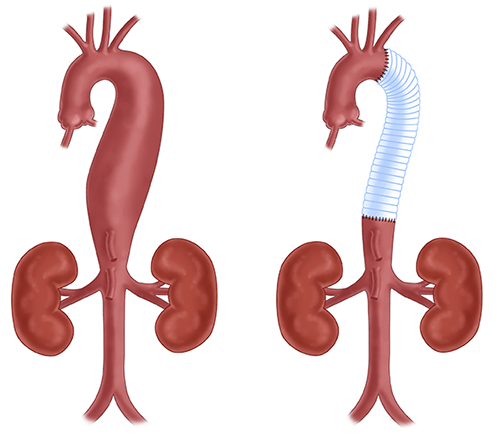Descending Thoracic and Thoracoabdominal Aortic Aneurysm Treatment
The UPMC Heart and Vascular Institute's Center for Aortic Disease offers a full range of state-of-the-art aneurysm treatment strategies for thoracic aortic aneurysms (TAAs) and thoracoabdominal aortic aneurysms (TAAAs) caused by:
Aneurysm treatment depends on its size and location and your overall health.
If your aneurysm is small and not causing symptoms, your doctor may choose to monitor your condition. Surgeons consider aneurysm repair surgery when the TAA or TAAA becomes large.
TAA and TAAA treatment overview
Open aneurysm repair - A surgeon makes an incision in your chest and replaces the weakened portion of the aorta with a fabric tube, called a graft.
The surgeon may either repair or bypass vessels, if the aneurysm involves important branches of the aorta.
- Where it occurs: Dilations of the aorta within the chest.
- We advise surgery when: TAA reaches 6 centimeters or more in size.
- Hospital stay: 5 to 7 days.
- Recovery time: 2 to 3 months for a complete recovery, depending on the complexity of your case or other conditions such as heart, lung, or kidney disease.
Endovascular procedures - Less invasive endovascular stent graft uses long, thin tubes (called catheters) inserted through small incisions in your groin.
- Can be used depending on location and shape of the TAA or TAAA.
- Once in place, blood flows through the stent-graft instead of into the aneurysm, eliminating the chance of rupture.

A thoracoabdominal aortic aneurysm (TAAA) is an enlargement in the aorta, occuring in the descending aorta, and located in the chest and abdomen. Extent I TAAA repairs use a synthetic graft to replace the majority of the descending thoracic aorta and the upper abdominal aorta.
A thoracoabdominal aortic aneurysm (TAAA) is an enlargement in the aorta, occuring in the descending aorta, and located in the chest and abdomen. Extent II TAAA repair uses a synthetic graft to replace the entire length of the thoracoabdominal aorta.
Our thoracic aortic disease treatment experience
Cardiothoracic and vascular surgeons at the UPMC Heart and Vascular Institute offer treatment for descending TAAs and TAAAs.
At our Center for Aortic Disease, patients have immediate access to state-of-the-art diagnostic and treatment strategies, including:
- Sophisticated 3D, volume-rendered, computed tomographic and magnetic resonance angiography to help produce optimal anatomic reconstruction strategies for the thoracic and thoracoabdominal aorta.
- Comprehensive neurocerebral and spinal cord protection protocols to optimize neurologic outcomes.
- Minimally invasive endovascular thoracic aortic repair with stent grafts for aneurysmal diseases, dissection processes, and traumatic injuries.
- Reconstruction of the aortic root with aortic valve-preserving strategies, including complex aortic valve repair techniques designed and championed by the center's own surgeons.
To refer a patient, contact the UPMC Center for Aortic Disease.
Learn More About Thoracic Aortic Disease Treatments
From the Society for Vascular Surgery
From our Health Library at UPMC.com




















